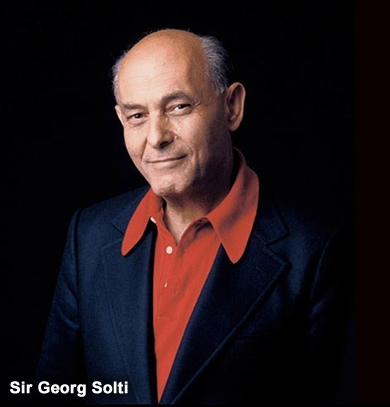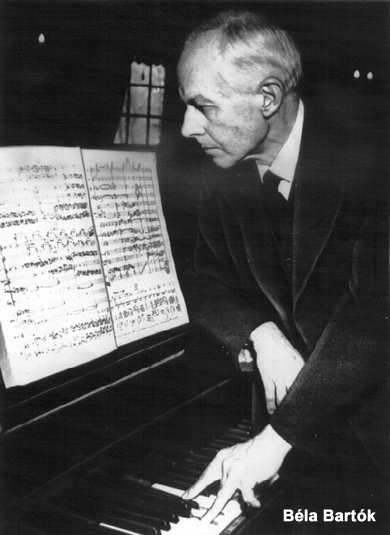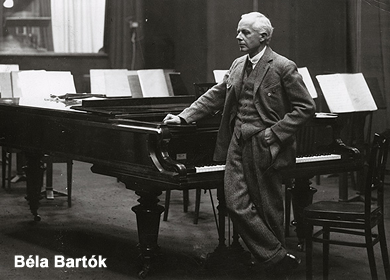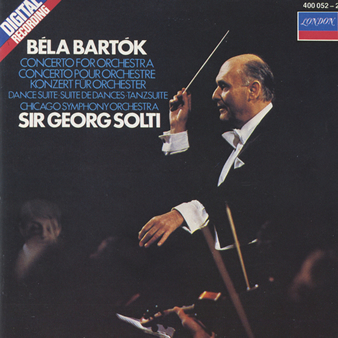Chicago Symphony Orchestra – Sir Georg Solti, conductor (London)
Recorded: Orchestra Hall, Chicago – January 1981
ONE-SENTENCE REVIEW:
Yeah, now we’re talking – that’s SIR Georg Solti to you, buddy – close personal friend of Mr. Bartok!
ORIGINAL LINER NOTES:
Bela Bartok, A Personal Note (Georg Solti, London, 1981):
“When I was studying music in Budapest, I was lucky enough to encounter Bela Bartok in very varied circumstances. He was a calm and introverted man, who spoke little, but who greatly enjoyed the company of young people and who was enormously touched by their admiration. Above all things he hated intolerance, dictatorship and fascism, which drove him from the native Hungary he so loved.
 First of all, I was in his piano class for a short time. He was a marvelous teacher, who never interrupted his pupils, but let them play through to the end and then took their place to show them how the piece should be played!
First of all, I was in his piano class for a short time. He was a marvelous teacher, who never interrupted his pupils, but let them play through to the end and then took their place to show them how the piece should be played!
A little later, as a member of the jury for the Liszt Academy’s composition examinations, he had occasion a number of times to judge my compositions, which must have been particularly horrible to him!
In 1938, I turned pages for him at the first public performance of his Sonata for Two Pianos and Percussion, which he played with his wife. This took place at the Budapest Opera, but sadly only the young people in the audience applauded the work and saw the true importance of such a masterpiece.
It was also at the Budapest Opera that I was able to watch him while he was supervising the production of The Miraculous Mandarin. He was very meticulous and I remember how he would stand in the hall, his metronome in his hand, checking the tempi.
When preparing these two works for the recording, I was determined that the tempi should be exactly as Bartok wrote and this led me to some extraordinary discoveries, chief of which was in the second movement of the Concerto for Orchestra. The printed score gives crochet equals 74, which is extremely slow, but I thought that I must follow what it says.
When we rehearsed I could see that the musicians didn’t like it at all and in the break the side drum player (who starts the movement with a solo) came to me and said “Maestro, my part is marked crochet equals 94,” which I thought must be a mistake, since none of the other parts have a tempo marking.
 The only way to check was to locate the manuscript and through the courtesy of the Library of Congress in Washington, we obtained a copy of the relevant page, which not only clearly showed crochet equals 94, but a tempo marking of Allegro scherzando (the printed score gives ‘Allegretto scherzando).
The only way to check was to locate the manuscript and through the courtesy of the Library of Congress in Washington, we obtained a copy of the relevant page, which not only clearly showed crochet equals 94, but a tempo marking of Allegro scherzando (the printed score gives ‘Allegretto scherzando).
Furthermore, Bartok headed it ‘Presentando le coppie’ (Presentation of the pairs) not ‘Giuocco delle coppie’ (Game of the pairs). I was most excited by this, because it becomes a quite different piece.
The programme of the first performance in Boston clearly has the movement marked ‘Allegro scherzando’ and the keeper of the Bartok archives was able to give us further conclusive evidence that the faster tempo must be correct.
I have no doubt that thousands of performances, including my own up until now, have been given at the wrong speed!”
BARTOK: CONCERTO FOR ORCHESTRA (Notes by: Lionel Salter):
While Bartok was ill in the USA in 1943, Koussevitzky came to his hospital room to offer him a commission for an orchestral work; in reality this had been urged by Szigeti and Fritz Reiner in an effort to alleviate the composer’s impoverished condition and his feelings of frustration, though this had to be kept secret from him, as his pride would not have allowed him to accept anything that smacked of charity.
The outcome was the Concerto for Orchestra – his last orchestral work except for the Third Piano Concerto and the unfinished Viola Concerto – which was completed in eight weeks and called for a very large orchestra, instruments often being treated “in a solostic manner,” as he said in his initial analysis.
 Its first performance in Boston on December 1, 1944 was an instant success. The gratified composer wrote in a letter, “Koussevitzky is very enthusiastic and says it is “the best orchestra piece of the last 25 years’ (including the works of his idol Shostakovich‘).” The last words refer to Bartok’s pique that, while he himself had been neglected, Shostakovich’s “Leningrad” Symphony, with its “ridiculous” march theme, had, owing to wartime feelings, been widely welcomed: the Concerto bears evidence of his understandable reaction.
Its first performance in Boston on December 1, 1944 was an instant success. The gratified composer wrote in a letter, “Koussevitzky is very enthusiastic and says it is “the best orchestra piece of the last 25 years’ (including the works of his idol Shostakovich‘).” The last words refer to Bartok’s pique that, while he himself had been neglected, Shostakovich’s “Leningrad” Symphony, with its “ridiculous” march theme, had, owing to wartime feelings, been widely welcomed: the Concerto bears evidence of his understandable reaction.
The andante opening of the Introduzione begins mysteriously with a characteristically Hungarian theme in the bass, built up on the interval of the fourth (which is to pervade the entire work and assume basic importance). A rhythmic theme of declamatory character develops from a flute phrase, and a rising five-note scale spanning a tritone appears, persists, and turns into the opening bar of the ensuing Allegro vivace, which is in orthodox sonata-form.
The first subject contains, in addition to the tritone scale, two rising fourths; and these (the second filled in with the intermediate notes) become the basis of a trombone theme, which is later to be taken up in two fugati.
The actual second subject, first heard on the oboe over a string drone, vacillates between two notes in a curious way. The movement as a whole is full of ingenious contrapuntal resource – including elaborate strettos and canons both forwards and in reverse – and culminates in a blazing statement by the brass of the early trombone theme.
The gay scherzo, in the printed score entitled Giuoco delle coppie, is in fact, int he composer’s manuscript, headed Presentando le coppie. A side drum without snares (in a rhythm about which the autograph reveals that Bartok had at first been undecided) ushers in the instruments, which trip on in pairs; the bassoons in sixths, the oboes in thirds, the clarinets in sevenths, the flutes in fifths, and the (muted) trumpets in major seconds.
The brass, accompanied by the side drum, then pronounce a benediction over the couples in the form of a short chorale (the opening notes of which are ingeniously derived from the closing line of the first movement) after which the instruments return in the same order as before, but this time fructified by additional instruments of their own (or similar) kind pattering along beside them, mirroring their activities or interlocking with them. A final cadence combines all the original instruments, in their initial relationships into a single chord.
 The Elegia harks back to the start of the Concerto, and uses among its kaleidoscopically-presented, folk-like material both the motif in fourths and the “declamatory” theme from the Introduzione.
The Elegia harks back to the start of the Concerto, and uses among its kaleidoscopically-presented, folk-like material both the motif in fourths and the “declamatory” theme from the Introduzione.
The scoring is impressionistic – an example of the “night music” which consistently obsessed Bartok – and at the end of the solo piccolo’s repeated single notes recall the repeated xylophone notes in the Music for Strings, Percussion and Celesta.
The fourth movement is basically an Intermezzo in which two folk-like melodies of flexible, wayward shape alternate. But halfway through comes a rude interruption. The clarinet forgets itself so far as to wander into a burlesque of the notorious march-tune in Shostakovich’s “Leningrad” Symphony (with a half-recollection of The Merry Widow at the back of its mind): it is greeted with jeers and catcalls from the orchestra, which then strikes up a German-band oom-pah bass over which the violins join in with the tune and are rowdily mocked by the wind; the tuba gives a final elephantine echo of the clarinet’s original lapse of taste.
Order being restored, the serene Intermezzo is resumed and, after short flute cadenza, ends with fragments of the first theme.
The Finale, the most considerable and brilliant movement of the Concerto, begins (after a brief horn-call) with a bustling perpetuum mobile in the strings, and throws off numerous thematic motifs, the most important of which is a trumpet theme that is extensively developed: it becomes the subject of a fugue, and is treated in inversion, stretto, augmentation, diminution and every other contrapuntal ingenuity.
There is an abbreviated recapitulation, and the movement ends with a short coda after the trumpet theme has been hammered out in triumph by the full brass.
BARTOK: DANCE SUITE:
The Dance Suite dates from exactly twenty years earlier. To celebrate the 50th anniversary of the amalgamation of the towns Buda and Pest, works were commissioned from three Hungarian composers (each in his forties at the time).
 These were played at a concert on November 19, 1923, which began with the Festival Overture by Dohnanyi, who conducted on that occasion: his piece has sunk virtually without a trace, but the other two works stand among the brightest jewels in their native repertoire.
These were played at a concert on November 19, 1923, which began with the Festival Overture by Dohnanyi, who conducted on that occasion: his piece has sunk virtually without a trace, but the other two works stand among the brightest jewels in their native repertoire.
Kadaly’s masterpiece, the Psalmas hungaricus, besides evoking a period of tragic strife in his country’s history, also expressed something of his own bitterness at his treatment by politically-motivated adversaries; but Bartok, who had suffered similarly from hostile attacks, and who moreover was in the midst of emotional crises in his domestic life, rose above these to produce a composition whose joyousness and immediacy of impact – not to speak of its brilliant construction – have ensured its lasting popularity.
It was soon taken up very widely – in Cincinnati, Prague, London (at a Henry Wood Promenade Concert) and throughout Germany – and when Vaclav Talich conducted it with his Prague orchestra in Budapest in 1926 the entire work, at the public’s insistence, had to be encored.
TRACK LISTING:
- 1-5: Concerto for Orchestra [I – 9:00; II – 6:05; III – 6:30; IV – 4:01; V – 9:30]
- 6: Dance Suite [15:52]
FINAL THOUGHT:
If you read through that (very informative, I thought) you definitely don’t want to read anything further from me. Go on with your lives! A brilliant recording and ANOTHER 88!
 Emily Sachs – President – Manka Music Group (A division of Manka Bros. Studios – The World’s Largest Media Company)
Emily Sachs – President – Manka Music Group (A division of Manka Bros. Studios – The World’s Largest Media Company)



